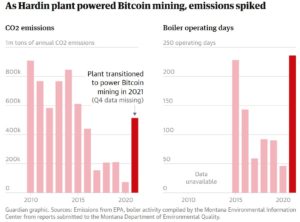By Ian Lund

Cryptocurrency mining facilities tend to crop up in areas with cool climates and cheap electricity. Like data centers, which are used to store information in the “cloud,” these buildings contain little else besides computers running 24/7 and HVAC systems to prevent overheating. They use incredible amounts of energy — mining a single bitcoin uses as much energy as an average household uses in 13 years. Given that one bitcoin is currently worth $37,000, it’s a clear injustice to prioritize the wealth of a few speculators over the energy needs of the many. Cheap energy in, funny money out.
Why make this business MEIC’s business? Crypto mines’ voracious demand for electricity is prolonging the life of fossil fuel generation plants. Specifically, crypto mines are buying or plugging into uneconomic, slated-to-close coal plants. Montana’s own Hardin Generating Station is a prime example of this trend — Meant to close in 2020, Hardin was bought by Marathon, a Bitcoin mining company, and today trades record-level coal-burning for digital money at great profit and great cost to our environment. It’s worth noting that other than a few jobs to maintain their operations, these facilities provide no value to local communities or the state of Montana.
Crypto mining advocates are quick to point out that the industry is working on “greening up” its electricity supply through renewable power purchase agreements or renewable energy credit offsets. However, renewable procurement does not occur in a vacuum. There is a finite amount of renewable development that can occur annually due to limited sites, interconnection constraints, and developer funds and capacity. Why should that clean energy go towards crypto get-rich-quick schemes rather than powering homes and businesses that provide value to Montanans?
So what’s MEIC’s game plan? Given that the costs of hosting and supplying electricity to crypto mines in Montana demonstrably outweigh the benefits, we are considering proposing policies to address the impacts of crypto mining. Many countries around the world, such as China, have outright banned mining for various reasons. No U.S. state has introduced regulations to slow development. Montana has an opportunity to lead the way in protecting its inhabitants and energy system from the undue burden of hosting crypto mining facilities.
We have identified four potential tiers of regulation, from most stringent to least.
- Ban large-scale crypto mining. This would solve the problem but will also create the most opposition.
- Impose a tax on every unit of cryptocurrency produced at a facility or on every kilowatt hour of electricity used. Energy usage might be easier to track and enforce.
- Mandate using renewable energy. Require that large-scale crypto mines procure their energy from renewable sources. This would still hamper the clean energy transition due to opportunity cost, but at least it protects clean air.
- Promote efficiency. Work within existing crypto structures to promote more energy efficient approaches to mining various currencies
Since it appears that cryptocurrency may be more than a passing fad, stay tuned for future action alerts.
This article was published in the March 2022 issue of Down To Earth.
Last modified: January 27, 2023

